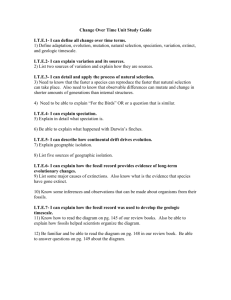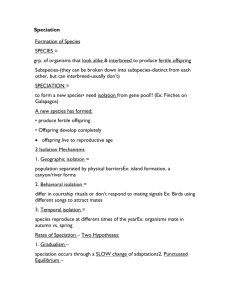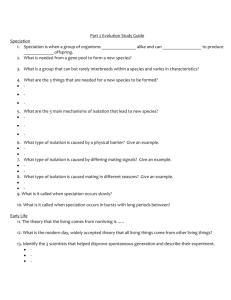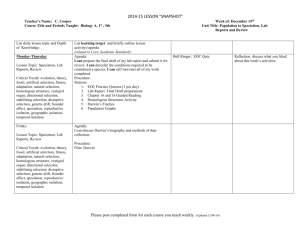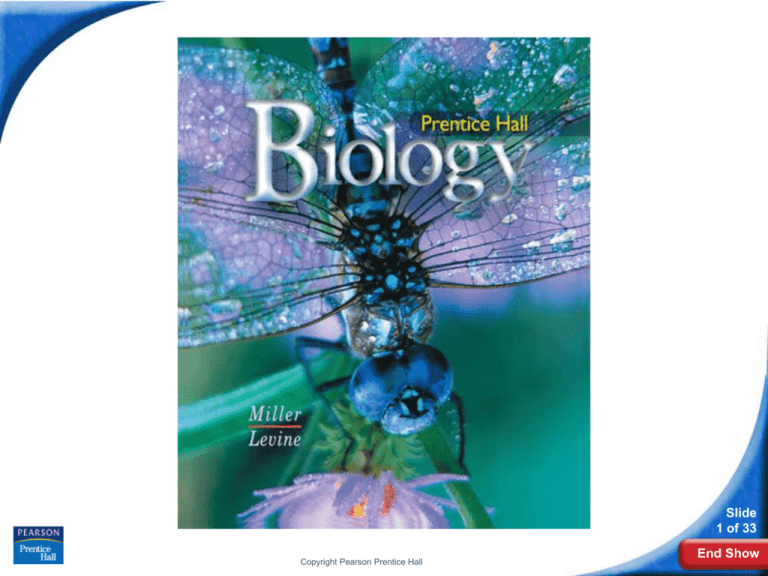
Biology
Slide
1 of 33
Copyright Pearson Prentice Hall
End Show
16-3 The Process of
Speciation
16-3 The Process of Speciation
Slide
2 of 33
Copyright Pearson Prentice Hall
End Show
16-3 The Process of Speciation 16-3 The Process of Speciation
Natural selection and chance events can change the
relative frequencies of alleles in a population and
lead to speciation.
Speciation is the formation of new species.
A species is a group of organisms that breed with
one another and produce fertile offspring.
Slide
3 of 33
Copyright Pearson Prentice Hall
End Show
16-3 The Process of Speciation
Isolating Mechanisms
What factors are involved in the formation
of new species?
The gene pools of two populations must
become separated for them to become new
species.
Slide
4 of 33
Copyright Pearson Prentice Hall
End Show
16-3 The Process of Speciation
Isolating Mechanisms
Isolating Mechanisms
As new species evolve, populations
become reproductively isolated from each
other.
When the members of two populations cannot
interbreed and produce fertile offspring,
reproductive isolation has occurred.
Slide
5 of 33
Copyright Pearson Prentice Hall
End Show
16-3 The Process of Speciation
Isolating Mechanisms
Behavioral Isolation
Behavioral isolation occurs when two populations
are capable of interbreeding but have differences
in courtship rituals or other reproductive strategies
that involve behavior.
Slide
6 of 33
Copyright Pearson Prentice Hall
End Show
16-3 The Process of Speciation
Isolating Mechanisms
Geographic Isolation
Geographic isolation occurs when two
populations are separated by geographic barriers
such as rivers or mountains.
Kaibab
Abert
Slide
7 of 33
Copyright Pearson Prentice Hall
End Show
16-3 The Process of Speciation
Isolating Mechanisms
Temporal Isolation
Temporal isolation occurs when two or more
species reproduce at different times.
Slide
8 of 33
Copyright Pearson Prentice Hall
End Show
16-3 The Process of Speciation
Testing Natural Selection
in Nature
Testing Natural Selection in Nature
Studies showing natural selection in action involve
descendants of the finches that Darwin observed
in the Galápagos Islands.
The finches Darwin saw were different, but he
hypothesized that they had descended from a
common ancestor.
Slide
9 of 33
Copyright Pearson Prentice Hall
End Show
16-3 The Process of Speciation
Testing Natural Selection
in Nature
Slide
10 of 33
Copyright Pearson Prentice Hall
End Show
16-3 The Process of Speciation
Testing Natural Selection
in Nature
Slide
11 of 33
Copyright Pearson Prentice Hall
End Show
16-3 The Process of Speciation
Testing Natural Selection
in Nature
Peter and Rosemary Grant tested Darwin’s
hypothesis, which relied on two testable
assumptions:
• For beak size and shape to evolve, there must be
enough heritable variation in those traits to
provide raw material for natural selection.
• Differences in beak size and shape must produce
differences in fitness, causing natural selection to
occur.
Slide
12 of 33
Copyright Pearson Prentice Hall
End Show
16-3 The Process of Speciation
Testing Natural Selection
in Nature
When food was scarce, individuals with large beaks
were more likely to survive.
Slide
13 of 33
Copyright Pearson Prentice Hall
End Show
16-3 The Process of Speciation
Speciation in Darwin's Finches
Speciation in Darwin's Finches
Speciation in the Galápagos finches
occurred by:
• founding of a new population
• geographic isolation
• changes in new population's gene pool
• reproductive isolation
• ecological competition
Slide
14 of 33
Copyright Pearson Prentice Hall
End Show
16-3 The Process of Speciation
Speciation in Darwin's Finches
Founders Arrive
A few finches—
species A—travel
from South
America to one of
the Galápagos
Islands.
There, they survive
and reproduce.
Slide
15 of 33
Copyright Pearson Prentice Hall
End Show
16-3 The Process of Speciation
Speciation in Darwin's Finches
Geographic Isolation
Some birds from
species A cross to
a second island.
The two
populations no
longer share a
gene pool.
Slide
16 of 33
Copyright Pearson Prentice Hall
End Show
16-3 The Process of Speciation
Speciation in Darwin's Finches
Changes in the Gene Pool
Seed sizes on the
second island
favor birds with
large beaks.
The population on
the second island
evolves into
population B, with
larger beaks.
Slide
17 of 33
Copyright Pearson Prentice Hall
End Show
16-3 The Process of Speciation
Speciation in Darwin's Finches
Reproductive Isolation
If population B birds cross back to the first island,
they will not mate with birds from population A.
Populations A and B are separate species.
Slide
18 of 33
Copyright Pearson Prentice Hall
End Show
16-3
Click to Launch:
Continue to:
- or -
Slide
19 of 33
End Show
Copyright Pearson Prentice Hall
16-3
When two species do not reproduce because of
differences in mating rituals, the situation is
referred to as
a. temporal isolation.
b. geographic isolation.
c. behavioral isolation.
d. reproductive isolation.
Slide
20 of 33
End Show
Copyright Pearson Prentice Hall
16-3
The most important factor involved in the
evolution of the Kaibab and Abert squirrels of
the American Southwest appears to be
a. temporal isolation.
b. geographic isolation.
c. behavioral isolation.
d. different food sources.
Slide
21 of 33
End Show
Copyright Pearson Prentice Hall
16-3
One finding of the Grants' research on
generations of Galápagos finches was that
a. natural selection did not occur in the finches
b. natural selection can take place often and
very rapidly.
c. beak size had no effect on survival rate of
the finches.
d. natural selection was slow and permanent.
Slide
22 of 33
End Show
Copyright Pearson Prentice Hall
16-3
All of the following played a role in speciation of
Galápagos finches EXCEPT
a. no changes in the gene pool.
b. separation of populations.
c. reproductive isolation.
d. natural selection.
Slide
23 of 33
End Show
Copyright Pearson Prentice Hall
16-3
Beak size in the various groups of Galápagos
finches changed primarily in response to
a. climate.
b. mating preference.
c. food source.
d. availability of water.
Slide
24 of 33
End Show
Copyright Pearson Prentice Hall
END OF SECTION

